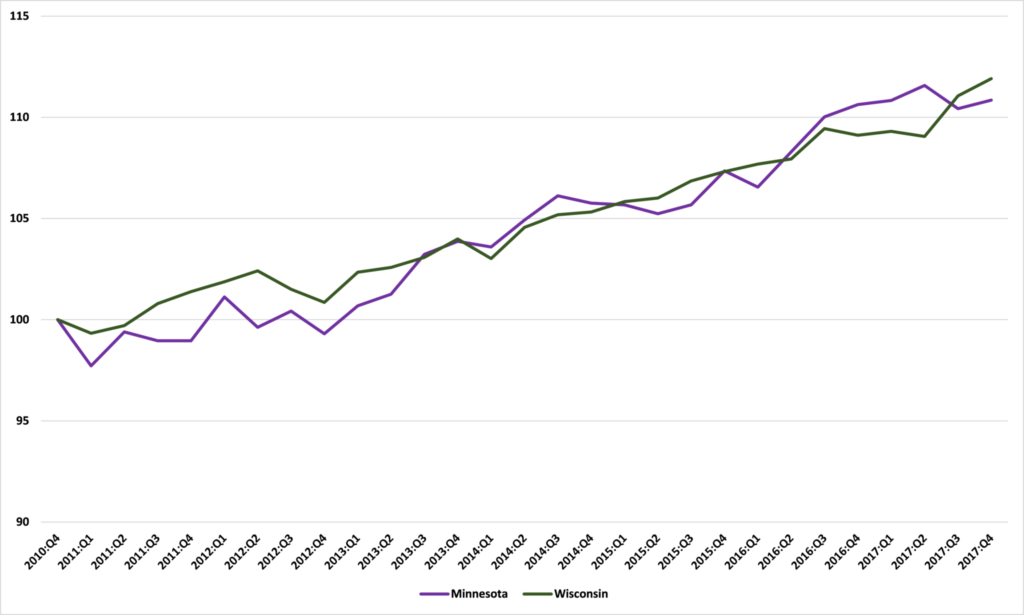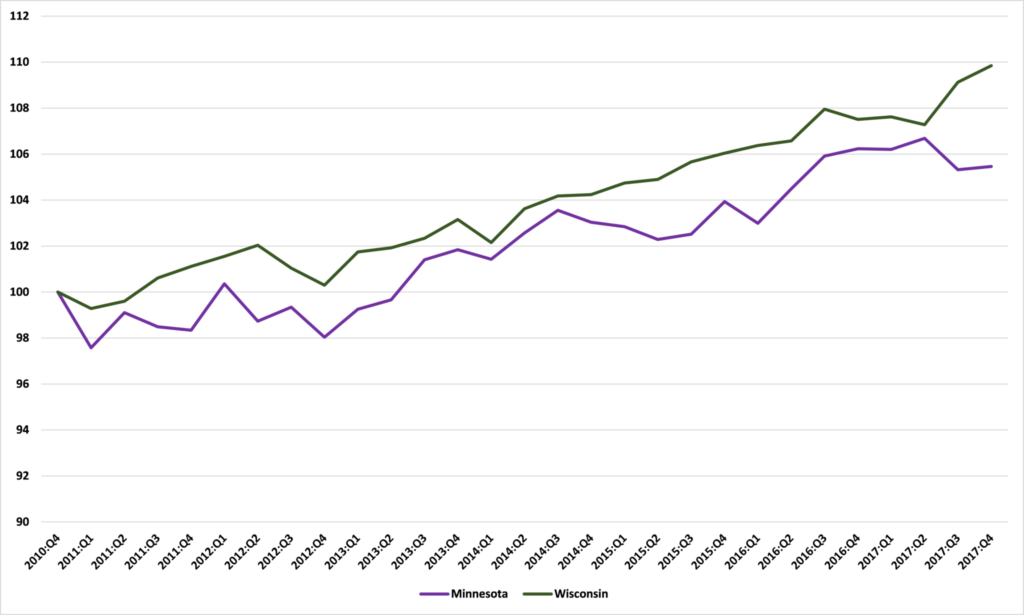Since Governors Dayton and Walker took office, Minnesota’s economic growth has lagged Wisconsin’s
A new report from the Economic Policy Institute argues that, since January 2011, when Mark Dayton became governor in Minnesota and Scott Walker became governor in Wisconsin, Minnesota’s economy has outperformed that of Wisconsin. But, looking at the data, this doesn’t appear to be the case.
Since January 2011, Wisconsin’s economy has grown faster than ours
The EPI’s report is subtitled ‘Since 2010, Minnesota’s economy has performed far better for working families than Wisconsin’s’. So, the first thing I looked for was the section on GDP. This amounts to just a paragraph, without an accompanying chart, on page 19. I’ll quote it below in full
Although gross domestic product (GDP) is a more abstract measure than many of the other measures already described, it is still worth noting that Minnesota also outperformed Wisconsin at the macroeconomic level, achieving stronger overall economic growth than Wisconsin in both aggregate and per-worker terms. According to the Bureau of Economic Analysis, from 2010 to 2016, Minnesota’s GDP grew by 12.8 percent in real (inflation adjusted) terms, while Wisconsin’s grew by 10.1 percent. The country as a whole had growth of 12.0 percent. On a per-worker basis, growth in Minnesota was 3.4 percent and in Wisconsin it was 2.7 percent. Nationally, per-worker GDP grew by only 0.1 percent.
It isn’t clear why the EPI are using annual data when there is quarterly data available covering the whole period. Indeed, the quarterly data runs into 2017. Using quarterly data allows us to select a more accurate base period, the fourth quarter of 2010, which covers October, November, and December. This is much more suitable for measuring the performances of guys who took office on the third day of the following quarter.
Table 1 shows the data for real GDP in the two states as downloaded from the Bureau of Economic Analysis. Figure 1 is based on that data. Both show that, contrary to what the EPI argues, since the final quarter of 2010, the last one before Governors Dayton and Walker took office, Wisconsin’s economy has grown by 11.9% and Minnesota’s by 10.9%. Both, it is true, have lagged the national average.
Table 1 – Real GDP by state (millions of chained 2009 dollars)

Source: Bureau of Economic Analysis and Center of the American Experiment
Figure 1 – Real GDP growth in Minnesota and Wisconsin, Q4:2010 to Q4:2017 (Q1:2010=100)

Source: Bureau of Economic Analysis and Center of the American Experiment
On a per capita basis, which is really what matters for economic well-being, the difference is even more stark. Table 2 shows the BEA’s quarterly estimates of state Real GDP divided by its quarterly estimates of the state’s populations to give real GDP per capita. Figure 2 is based on that data. Both show that, since the fourth quarter of 2010, per capita GDP in Wisconsin has grown by 9.8% while it has grown by just 5.5% in Minnesota. This is because, as the EPI says, Wisconsin’s population has grown less quickly than Minnesota’s over this period, by 1.9% compared to 5.1% here. Since Governor Walker took office, GDP per capita in Wisconsin has risen from 86.7% of Minnesota’s to 90.3%.
Table 2 – Real per capita GDP by state (chained 2009 dollars)

Source: Bureau of Economic Analysis and Center of the American Experiment
Figure 2 – Real GDP per capita growth in Minnesota and Wisconsin, Q4:2010 to Q4:2017 (Q1:2010=100)

Source: Bureau of Economic Analysis and Center of the American Experiment
As I’ve written before, economic theory and evidence show that an increasing population doesn’t necessarily make the average resident better off. These figures offer another example of that.
There is much more to the EPI report than just these figures, and I will examine other areas in coming days. But it is strange that a report on two state economies should treat their GDP figures, the key metric of economic activity, in such a throwaway manner. Looking at the data, perhaps we can understand why.
John Phelan is an economist at the Center of the American Experiment.
Photo Credit: Mike Morbeck